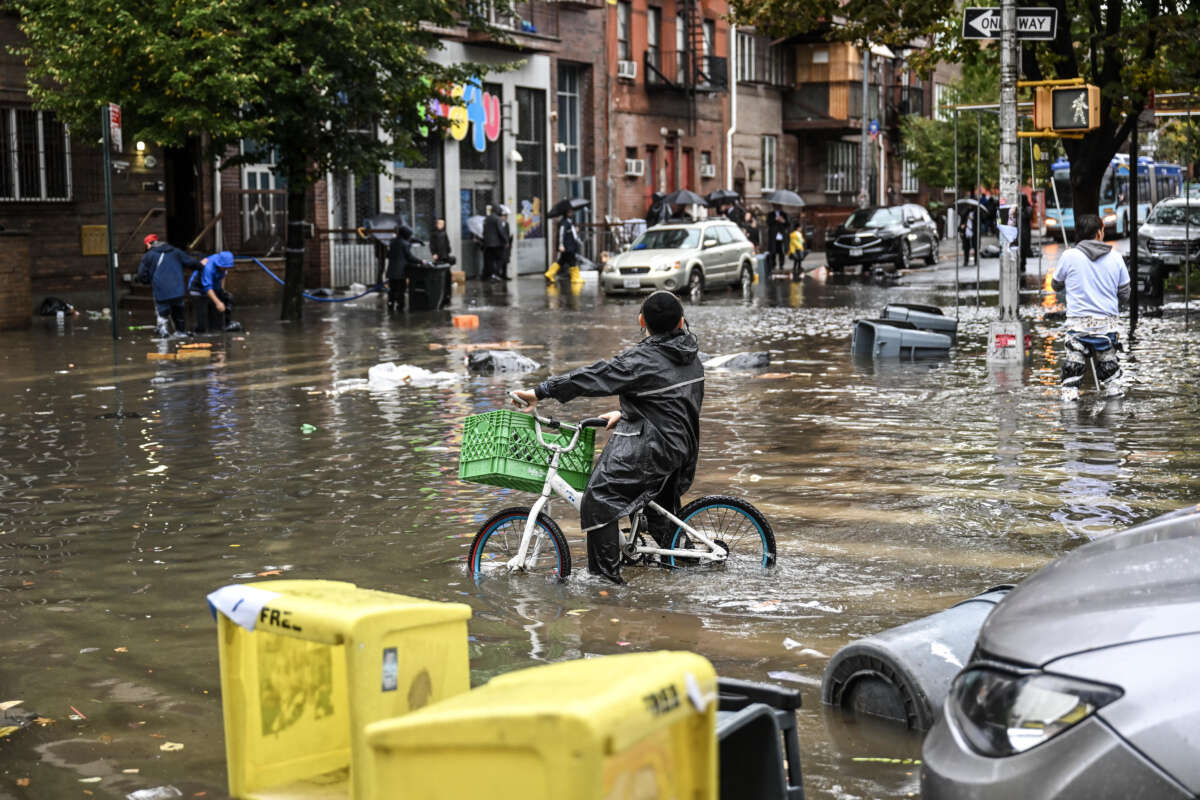The climate crisis made the record-breaking storm that flooded the streets of New York City on Friday as much as 20% wetter than it would have been without the burning of fossil fuels, a new study has found.
The rapid attribution study from European group ClimaMeter published Monday concluded that Friday’s extreme precipitation was “mostly strengthened” by global heating.
“Human-driven climate change plays a dual role, both intensifying these storms and warming the atmosphere,” study coauthor Davide Faranda of the Institut Pierre-Simon Laplace in France told The Guardian. “Deeper storms yield more intense phenomena, while a warmer atmosphere can accommodate a greater amount of rain.”
#NewReport Heavy precipitation ☔️ in #NewYork mostly strengthened by human-driven #climatechange 🌎🌡️
— ClimaMeter (@ClimaMeter) October 2, 2023
Visit https://t.co/rzCjsJzsOA and contact authors Tommaso Alberti @INGVambiente, @DaviFaranda from @IPSL_outreach @ErikaCoppolaE from @ictpnews, #newyorkflooding pic.twitter.com/iHN6nGIxqu
New York City on Friday certainly saw a “great amount of rain” as around eight inches fell on JFK airport, the most in a single day since record-keeping began in 1948, the study authors observed. The deluge flooded streets with nearly five feet of water, disrupting both underground and above-ground train service and prompting Democratic Gov. Kathy Hochul to declare a state of emergency.
“While no fatalities have been reported, scenes of chaos emerged as residents waded through knee-deep water in search for higher ground and drivers abandoned their vehicles on overwhelmed highways,” the study authors wrote.
Apparently the NWS station at JFK airport, set up in 1948, has just set its one-day rainfall record.
— Bill McKibben (@billmckibben) September 29, 2023
It's a new, wet world out there. https://t.co/PFQVaRvG25
The immediate cause of Friday’s storm was the meeting of cold air from Canada and warm air from the Gulf of Mexico, the study authors explained. While these types of events are part of regular weather patterns, the researchers used a peer-reviewed methodology to compare Friday’s system to similar events between 1979 and 2000 and 2000 and 2022 in order to asses the influence of the climate crisis. In this case, they concluded that such low-pressure systems were not more intense, but are now producing more precipitation in the region and occurring later in the year.
Overall, they found that such storms now dump three to 15 millimeters of rain more per day than they did in the past, making them 10% to 20% wetter, according to The Guardian.
“Human-driven climate change is the primary driver, underscoring the urgent need for climate mitigation and adaptation efforts,” study coauthor Tommaso Alberti of Italy’s Istituto Nazionale di Geofisica e Vulcanologia told The Guardian.
Climate scientist Michael Mann, who was not involved with the research, told The Guardian that rapid attribution studies could leave out some factors involved with major storms but also concluded the climate crisis was responsible for the severity of the New York floods.
“New York is experiencing a very clear increase in these extreme — more than two inches per hour — rainfall events, and that’s clearly tied to a warming atmosphere,” he said.
Friday’s floods have led to calls from New Yorkers for improved infrastructure and emergency communications, as well as broader calls for climate action.
Just last week, over 75,000 people marched in the streets of New York to demand climate action. Those streets are now flooded. @GovKathyHochul declared a state of emergency as over 8.5 million people were placed under flash flood warnings.
— Earthjustice (@Earthjustice) September 29, 2023
⁰
It costs more to do nothing. pic.twitter.com/6oUZ5ggs1y
New York’s sewers are only capable of managing 1.75 inches of water per hour, according to The City. But some parts of the city saw as much as 2.5 inches an hour Friday, CNBC reported. A Federal Emergency Management Agency report published this summer warned that most of the nation’s urban drainage systems were not up to the increased rainfall brought by a warmer atmosphere, as Mother Jones pointed out.
“The sad reality is our changing climate is changing faster than our infrastructure can respond,” city Chief Climate Officer Rit Aggarwala told The City.
5 Days Left: All gifts to Truthout now matched!
From now until the end of the year, all donations to Truthout will be matched dollar for dollar up to $50,000! Thanks to a generous supporter, your one-time gift today will be matched immediately. As well, your monthly donation will be matched for the whole first year, doubling your impact.
We have just 5 days left to raise $50,000 and receive the full match.
This matching gift comes at a critical time. As Trump attempts to silence dissenting voices and oppositional nonprofits, reader support is our best defense against the right-wing agenda.
Help Truthout confront Trump’s fascism in 2026, and have your donation matched now!
